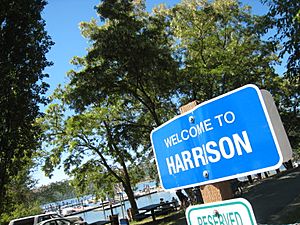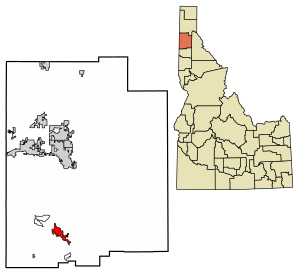Harrison, Idaho facts for kids
Quick facts for kids
Harrison, Idaho
|
|
|---|---|

Welcome sign in Harrison
|
|

Location of Harrison in Kootenai County, Idaho.
|
|
| Country | United States |
| State | Idaho |
| County | Kootenai |
| Area | |
| • Total | 4.40 sq mi (11.40 km2) |
| • Land | 3.56 sq mi (9.23 km2) |
| • Water | 0.84 sq mi (2.18 km2) |
| Elevation | 2,274 ft (693 m) |
| Population
(2010)
|
|
| • Total | 203 |
| • Density | 60.64/sq mi (23.41/km2) |
| Time zone | UTC-8 (Pacific (PST)) |
| • Summer (DST) | UTC-7 (PDT) |
| ZIP codes |
83833, 83842
|
| Area code(s) | 208 |
| FIPS code | 16-35200 |
| GNIS feature ID | 2410708 |
Harrison is a small city in Kootenai County, Idaho, United States. In 2010, about 203 people lived there. Harrison is located on the eastern side of Lake Coeur d'Alene. It's right where the Coeur d'Alene River flows into the lake.
Contents
History of Harrison
Harrison got its name from President Benjamin Harrison. It was an important spot because of a large wood mill. Mining boats from the nearby Coeur d'Alene River also stopped here.
Harrison became an official city in 1899. It was once the biggest city on Lake Coeur d'Alene.
Early Growth and Development
Harrison grew from a small settlement to a busy village in about 12 years. A railroad line from Tekoa, Washington, reached Harrison in 1890. This helped the town grow a lot.
In 1891, Silas W. Crane settled near the city. He built the first house in Harrison. This house is now the Crane House Museum. That same year, Fred Grant moved a sawmill to Harrison. It was called Grants Mill and could process 60,000 feet of wood each day.
In 1892, S.W. Crane opened a General Store. The first Post Office was set up in 1893. W.E. Crane became the first postmaster. More stores opened in the next few years.
The first newspaper, The Signal, started in 1895. Later, it was called The Mountain Messenger. By 1900, it became The Searchlight. A paper with this name is still published every year.
In 1895, a Methodist church was built. School District #29 was also formed. The first school classes were held in the church. The first school building was built in 1896. By 1903, there were 59 students.
The original town area was shaped like a triangle. It covered about 23 acres. The Village of Harrison officially became a city on July 21, 1899. George W. Thompson was chosen as the first chairman of the Board of Trustees.
Modern Services and Industry
In 1905, a company from Spokane built a water system for Harrison. It cost $20,000. An electric light plant was also installed in 1901.
The next year, the telephone arrived. Harrison could then connect with other towns. Rocky Mountain Bell bought the telephone system later that year. This connected Harrison to the outside world.
Soon, Harrison had a bank, an opera house, and many different stores. There were drugstores, grocery stores, hardware stores, and clothing shops. You could also find tailors, blacksmiths, shoemakers, restaurants, hotels, and even a hospital.
Around 1900, Harrison was the largest town in Kootenai County. In 1911, the city had about 1,250 people. This growth was thanks to eight or more sawmills and box factories. These mills and logging jobs employed about 280 men. They earned around $25,000 a month. Millions of feet of timber were stored in Lake Coeur d’Alene. The lake and nearby rivers were key ways to move timber from the forests.
Challenges and Community Spirit
In 1917, the Grant Lumber Company caught fire. This huge fire destroyed about half of Harrison's homes and businesses. Much of the town was never rebuilt.
Getting to Harrison was easiest by water. The OWR&N Company built a large steamboat called "The Harrison." It could carry 600 passengers. Other steamers also carried people and goods. The train depot was a popular place for kids. Passenger service stopped in the early 1920s. Freight continued until 1932, when the line closed.
Many old photos and facts about Harrison are at the Crane Historical Society Museum. The community spirit is still strong today. The Old Time Picnic is held every year on the last weekend in July.
A trail head for the "Trails of Coeur d’Alenes" is in Harrison. This trail helps keep the town busy when there are fewer boats on the lake. The trail is 72 miles long and goes from Plummer to Mullan. It's great for easy bike rides.
Organizations in Harrison
Churches
- Harrison Community Baptist Church
- Our Lady of Perpetual Help Catholic Church
Clubs and Groups
- Crane Historical Society
- Harrison Area Ball Fields Association
- Harrison Chamber of Commerce
- TOPS - Take Off Pounds Sensibly (a weight loss support group)
- Harrison Grange #422
- Old Time Picnic Committee
Geography of Harrison
Harrison is located at 47°26′59″N 116°46′50″W / 47.44972°N 116.78056°W.
The city covers about 0.76 square miles (1.97 square kilometers). Most of this is land, with a small part being water.
Harrison is about 28 miles (45 kilometers) south of Interstate 90. You can reach it by driving on Highway 97, which is part of the scenic Lake Coeur d'Alene Byway.
The Coeur d'Alene River flows into Lake Coeur d'Alene right at Harrison's northern edge. The area around the river is full of smaller lakes. So, water is a big part of the local landscape. The Saint Joe Mountains, part of the Bitterroot Range, rise high above the flat lakes around Harrison.
Population Facts
| Historical population | |||
|---|---|---|---|
| Census | Pop. | %± | |
| 1900 | 702 | — | |
| 1910 | 932 | 32.8% | |
| 1920 | 674 | −27.7% | |
| 1930 | 493 | −26.9% | |
| 1940 | 362 | −26.6% | |
| 1950 | 322 | −11.0% | |
| 1960 | 249 | −22.7% | |
| 1970 | 249 | 0.0% | |
| 1980 | 260 | 4.4% | |
| 1990 | 226 | −13.1% | |
| 2000 | 267 | 18.1% | |
| 2010 | 203 | −24.0% | |
| 2019 (est.) | 216 | 6.4% | |
| U.S. Decennial Census | |||
Harrison's Population in 2010
In 2010, the city of Harrison had 203 people living there. There were 100 households. About 19% of households had children under 18. Most people living in Harrison were White (98.5%). A small number (1.5%) were Native American. About 2% of the population was Hispanic or Latino.
The average age in Harrison was 52.6 years old. About 17.7% of residents were under 18. And 26.6% were 65 years or older. The number of males and females was almost equal.
See also
 In Spanish: Harrison (Idaho) para niños
In Spanish: Harrison (Idaho) para niños


